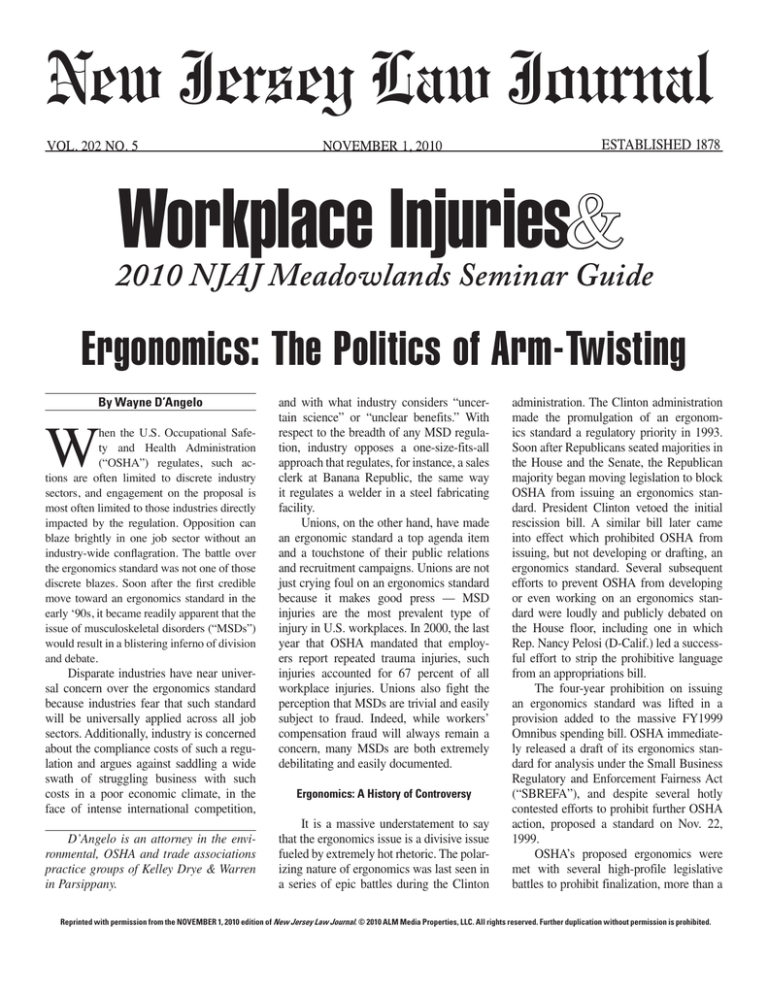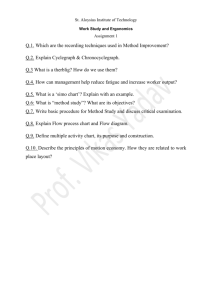
New Jersey Law Journal
VOL. 202 NO. 5
NOVEMBER 1, 2010
ESTABLISHED 1878
Workplace Injuries&
2010 NJAJ Meadowlands Seminar Guide
Ergonomics: The Politics of Arm-Twisting
W
By Wayne D’Angelo
hen the U.S. Occupational Safety and Health Administration
(“OSHA”) regulates, such actions are often limited to discrete industry
sectors, and engagement on the proposal is
most often limited to those industries directly
impacted by the regulation. Opposition can
blaze brightly in one job sector without an
industry-wide conflagration. The battle over
the ergonomics standard was not one of those
discrete blazes. Soon after the first credible
move toward an ergonomics standard in the
early ‘90s, it became readily apparent that the
issue of musculoskeletal disorders (“MSDs”)
would result in a blistering inferno of division
and debate.
Disparate industries have near universal concern over the ergonomics standard
because industries fear that such standard
will be universally applied across all job
sectors. Additionally, industry is concerned
about the compliance costs of such a regulation and argues against saddling a wide
swath of struggling business with such
costs in a poor economic climate, in the
face of intense international competition,
D’Angelo is an attorney in the environmental, OSHA and trade associations
practice groups of Kelley Drye & Warren
in Parsippany.
and with what industry considers “uncertain science” or “unclear benefits.” With
respect to the breadth of any MSD regulation, industry opposes a one-size-fits-all
approach that regulates, for instance, a sales
clerk at Banana Republic, the same way
it regulates a welder in a steel fabricating
facility.
Unions, on the other hand, have made
an ergonomic standard a top agenda item
and a touchstone of their public relations
and recruitment campaigns. Unions are not
just crying foul on an ergonomics standard
because it makes good press — MSD
injuries are the most prevalent type of
injury in U.S. workplaces. In 2000, the last
year that OSHA mandated that employers report repeated trauma injuries, such
injuries accounted for 67 percent of all
workplace injuries. Unions also fight the
perception that MSDs are trivial and easily
subject to fraud. Indeed, while workers’
compensation fraud will always remain a
concern, many MSDs are both extremely
debilitating and easily documented.
Ergonomics: A History of Controversy
It is a massive understatement to say
that the ergonomics issue is a divisive issue
fueled by extremely hot rhetoric. The polarizing nature of ergonomics was last seen in
a series of epic battles during the Clinton
administration. The Clinton administration
made the promulgation of an ergonomics standard a regulatory priority in 1993.
Soon after Republicans seated majorities in
the House and the Senate, the Republican
majority began moving legislation to block
OSHA from issuing an ergonomics standard. President Clinton vetoed the initial
rescission bill. A similar bill later came
into effect which prohibited OSHA from
issuing, but not developing or drafting, an
ergonomics standard. Several subsequent
efforts to prevent OSHA from developing
or even working on an ergonomics standard were loudly and publicly debated on
the House floor, including one in which
Rep. Nancy Pelosi (D-Calif.) led a successful effort to strip the prohibitive language
from an appropriations bill.
The four-year prohibition on issuing
an ergonomics standard was lifted in a
provision added to the massive FY1999
Omnibus spending bill. OSHA immediately released a draft of its ergonomics standard for analysis under the Small Business
Regulatory and Enforcement Fairness Act
(“SBREFA”), and despite several hotly
contested efforts to prohibit further OSHA
action, proposed a standard on Nov. 22,
1999.
OSHA’s proposed ergonomics were
met with several high-profile legislative
battles to prohibit finalization, more than a
Reprinted with permission from the NOVEMBER 1, 2010 edition of New Jersey Law Journal. © 2010 ALM Media Properties, LLC. All rights reserved. Further duplication without permission is prohibited.
2
NEW JERSEY LAW JOURNAL, NOVEMBER 1, 2010
thousand witnesses at OSHA’s public meetings, and hundreds of thousands of public
comments from stakeholders and supporters
of both sides of the issue. OSHA published
its final standard on Nov. 14, 2000, days
after the election of George W. Bush. As one
of its last acts, the outgoing Clinton administration rushed to make the ergonomics standard take effect on Jan. 16, 2001 — again
days before the executive branch was ceded
to the Republicans.
The ergonomics standard lasted
about a month before both the House and
Senate invoked the Congressional Review
Act to disapprove the ergonomic standard,
and was officially killed by President Bush’s
execution of the resolution of disapproval on
March 20, 2001.
President Bush’s Slow Roll
President Bush signed the resolution
of disapproval in order to “pursue a comprehensive approach on ergonomics.” By
all accounts, President Bush did not seek
such an approach. Indeed, in his two terms
in office, the Bush OSHA pursued only
nonbinding guidelines governing the poultry
processing industry, retail grocery workers,
nursing homes and the shipbuilding industry. To his credit, President Bush lived up
to campaign promises to provide businesses
tools for compliance instead on relying on
heavy-handed enforcement. These industryspecific guidelines do, in fact, give employers tools to protect their workers. Similarly,
these industries were appropriately targeted
because of their high incidences of MSDs.
Still, it is a stretch to view these efforts as
“comprehensive.”
President Bush’s sole economy-wide
ergonomics initiative was to revoke the
requirement that regulated employers identifying MSDs on their 300 logs. OSHA 300
logs are the documents on which employers
report to OSHA employees’ work-related
injuries or illnesses. Until June of 2003,
OSHA 300 logs contained definitions of
MSDs and a section wherein employers
could report an injury as being such.
Round II?
Eight years of relative inactivity by the
Bush administration has done little to erase
the bitterness of the Clinton-era ergonomics
battles. To the contrary, it may have fueled
it. For every ergonomics opponent that was
enraged by President Clinton’s rushed promulgation with one foot out the door, there
are an equal number of ergonomics supporters angry that President Bush lost nearly a
decade to inactivity and leniency.
Early in President Obama’s administration, the stars seemed to be aligning for a
new comprehensive ergonomics standard. The composition of Congress had shifted
toward ergonomics proponents and many of
the most vocal proponents, such as Speaker
Pelosi, began to enjoy more political muscle. David Michaels, the head of OSHA, was
expected be an aggressive regulator, was
an outspoken proponent of an ergonomics
standard, and even wrote a book which, in
part, strongly criticized, ergonomics opponents. Further, President Obama himself is
closely tied to the labor unions that championed and financed the pro-ergonomic fight.
Still, an administration has to pick its
battles, and President Obama picked an
ambitious set for his first term. While the
President can put health care reform in his
“win” column, his victory was bruising
and required the expenditure of a great deal
of political capital. The President’s efforts
with respect to climate change also met
stiff opposition and sapped additional political capital. His administration scored some
victories moving climate regulation through
EPA but saw its favored legislation stalled
on Capitol Hill.
The question remains whether President
Obama has the stomach or the stamina to
pick a fight on ergonomics. His administration’s initial efforts suggest that the
President is intent on reversing Bush-era
policy changes. Specifically, the Obama
OSHA has proposed to reestablish a definition of MSDs and to again require 300 log
recordkeeping and reporting of MSDs. A
final rule is expected imminently.
Further, this spring, OSHA announced
that it would begin enforcing ergonomic
standards under the General Duty Clause
of the Occupational Safety and Health Act
(“OSH Act”). The General Duty Clause
requires all employers to provide their
employees workplaces that are free of recognized hazards. Traditionally, OSHA relies
on the General Duty Clause as a catch-all
when a potential dangerous condition at a
workplace does not violate a specific provision of the OSH Act or OSHA regulations.
Still, it is difficult to tell whether
202 N.J.L.J. 444
President Obama’s reversal of Bush-era
approaches on reporting and enforcement
is the camel’s nose under the tent for future
regulation or whether such action is the most
that can be mustered by an administration
that is beleaguered by a floundering economy and other priorities. A lot has changed
since the bullish early days of the Obama
administration and a lot has remained the
same. Unfortunately, the economic and
employment situations have not improved in
any readily appreciable way. Americans are
worried about their jobs and angry about the
returns on the stimulus money. Individual
and generic polls suggest that voters will
take their economic dissatisfaction out on
the Democratic majorities in the House and
Senate as well as the states. While smart
people disagree about how many and which
seats go Republican, almost nobody disagrees that the Republican Party will make
significant gains.
While such gains do not directly impact
the President’s ability to regulate MSDs
through OSHA (other than the potential for
Clinton-era rescission efforts on Capitol Hill),
the underlying economic and employment
dissatisfaction may guide the hand of this
extremely politically astute administration. An
ergonomics standard will impose costs on
domestic businesses. Whether such costs are
excessive, unnecessary, or will lead to any job
loss is almost immaterial. The mere public
perception that this administration is seeking
to saddle domestic industries with additional
costs after facing similar criticisms with respect
to climate change and health care may chill the
Administration’s appetite for an ergonomics
standard. To be sure, ergonomics opponents are
licking their chops for an opportunity to hammer the administration on ergonomics and job
loss. The President’s administration is staffed
with the veterans of the Clinton-era ergonomics battle. They know an MSD standard will not
squeak by like most OSHA standards. If there
was a time in this administration to push for
an ergonomics standard, that time has passed
— at least for now. Given this administration’s
allocation of political capital on competing
priorities and the continuing public concern
over employment and any measure that could
adversely affect employment, OSHA may find
it most prudent to continue to use the General
Duty Clause to enforce in egregious situations, to use the 300 log information to build a
case for a future regulation and to live to fight
another day.



